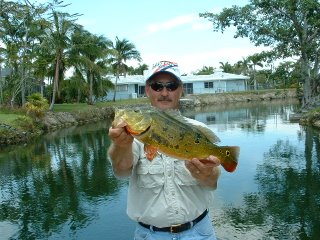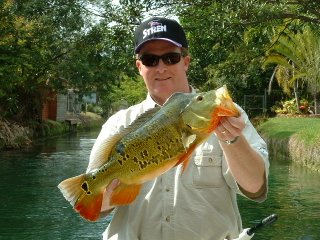Pavones made in U.S.A.
"If you ever make it to South Florida I'd be glad to take you
fishing for peacocks or largemouth bass. Thanks and tell
your friend"

Este es un mensaje que me envió Chuck Westlake, que conocí en la competencia de Caruachi, vive en el estado de la Florida en Miami y es un guia de pesca, especializado en pavones, los cuales se pescan en los canales de Miami. También lleva pescadores al Lago Okeechobee, donde se pescan los largemouth bass. Su mensaje es una invitación a pescar cuando pasen por el sur de la Florida.
Asi, que si pasan por Miami lo pueden localizar en el (954) 445-1811 y su página es: http://www.southfloridafishing.org
Esta es otra foto de Chuck con un largemouth bass:

Estos son algunos clientes de Chuck con sus pavones:





Como llegaron estos pavones a Florida y por que solo estan en los canales de Miami? Llegaron de Venezuela alrededor de 1984 y se quedaron en los canales, por que es donde se pueden proteger del frio y sobrevivir. Anexo más informacion y se las traduzco cuando llegue de Vacaciones:
"Peacock Cichlid (Cichla ocellaris). This species is sometimes called the butterfly peacock and belongs to the genus Cichla, which contains several species that are not well described. This creates confusion among professional fishery biologists. Eigenmann and Allen (1942) lumped several species as synonyms for Cichla ocellaris and C. temensis (Ogilvie 1966). The native range of the genus includes the rivers and lakes of the Amazon regions of Brazil and Bolivia, Peru, Venezuela, and Guyana. Ogilvie (1966a,b) summarized the general life-history information and the efforts to evaluate several species of peacock cichlids for introductions into Florida. Four seemingly different species were imported into Florida from the Orinoco River in Venezuela. All of the fishes were evaluated for introduction as game. Some isolated ponds were stocked with them, but none of the fishes survived, probably because of water temperatures in winter (Paul Shafland, Director, Non-native Fish Research Laboratory, Boca Raton, Florida, personal communication). All species were strictly pisciverous and not selective about size or species of forage fish. In their native range, some species grow to a maximum size of 13.5 kg, whereas other species average 1 to 2 kg. All species were potential sport fishes.
In the 1980's, fingerlings of Cichla ocellaris and C. temensis were imported from different geographical areas in South America (Brazil, Guyana, and Peru) into Florida and cross bred within species to maximize genetic species specific variability (Shafland 1984). Additional peacock cichlids, obtained from Texas, that had originally been obtained from Florida from the earlier stock, were bred with the recent imports. Resulting young were raised in Boca Raton, Florida. Between 1984 and 1986, Dade County canals were stocked with 20,000 peacock cichlid. Spawning began at 27 C. Shafland (1984) stated that studies with control temperatures conclusively revealed the inability of the peacock cichlid to survive water temperatures less than 15 C. After comparing the temperature tolerance found in the literature (Swingle 1966; Guest et al. 1979; Guest and Lyons 1980) with the results of temperature tolerance tests that he had completed earlier for other tropical fish species (Shafland and Piestrak 1982), Shafland (1984) concluded that peacock cichlid are considerably less tolerant of low water temperatures than any other currently established tropical fishes in Florida. Shafland (1984) later stated that the peacock cichlid, because of its lower lethal temperature tolerance of 15 C, could only survive in several major drainage canals in the most southern part of Florida. Temperatures in the North New River Canal near Ft. Lauderdale normally fall below 15.6 C (Anderson 1975). Water temperatures in winter during 1982-83 indicated that the species could survive in canals south of Miami but not in most natural freshwater habitats like the Everglades--not even during mild winters (Shafland 1984, 1989, 1990). Peacock cichlids cannot survive salinities that exceed 18 ppt.
The present established range of the peacock cichlid includes the coastal canals of eastern Dade and Broward counties within 50 km of the east coast of Florida and north to the Palm Beach-Broward county line (Morello 1993). The westward spread extends to the edge of the Everglades Conservation Area, 4.8 to 9.6 km south of the junction of U.S. Highway 27 and Interstate Highway 75 (Alligator Alley), where peacock cichlids have been caught by anglers. Although some fishery biologists are concerned that the peacock cichlid will become established in the Everglades National Park, Shafland (P. Shafland, Director, Non-native Fish Research Laboratory, Boca Raton, Florida, personal communication) believes that the existing range of the species will be reduced to the coastal canals of Dade County as soon as a colder-than-average winter occurs. This species is expanding its range because of its own ability to spread through interconnecting canals, the continued stocking of waters with the fish by the Game and Freshwater Fish Commission, and unofficial releases by anglers into favorite fishing areas. No studies have been conducted to determine the impact on largemouth bass populations that were in the canals before the introduction of the peacock cichlids. The peacock cichlid, released in 1984 by the Florida Game and Freshwater Fish Commission, was the first legally introduced exotic species into the waters of Florida (Shafland 1993). It has overwintered and reproduced every year since it was introduced. Self-sustaining populations now exist in 530 km of canals, where they are heavily sought after by anglers. Bait and tackle stores are promoting the taking of the species, and special guide services have developed for this species (Tucker 1988). In 1989, a 12-month standard creel census revealed that people fished for this species. The estimated fishing pressure was 31,662 hours on 40 surface hectares of canal (792 h/ha). This provides an estimated 425,000 hours of recreational fishing year and an estimated annual economic worth of $1.4 million (Shafland 1993). Only 2 peacock cichlids/day can be taken, and only one can be more than 43.2 cm in total length. The current state record is a 3.4 kg fish caught by an angler in April 1992. The average size caught by anglers is in the range of 0.5-1.0 kg, but fishes as heavy as 4.5 kg may be taken.
Speckled Pavon (Cichla temensis). This species is sometimes called the speckled peacock. It was collected from the Orinoco River, Venezuela, during earlier efforts to determine the feasibility of introducing it into Florida (Ogilvie 1966a). It grows at a slower rate and may be less prolific than the peacock cichlid and is still protected from harvest in Florida (Chapman 1989). In its native waters, fishes as heavy as 13.6 kg have been taken. This species is not yet listed as established in Florida."


0 Comments:
Publicar un comentario
<< Home